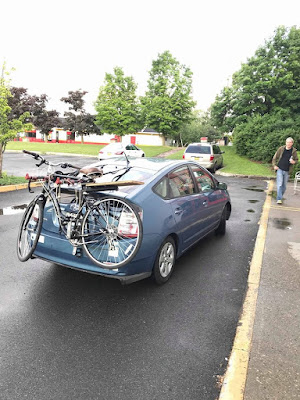“I’m the worst, I’m totally garbage at scheduling” is not an excuse; it’s just a sign that you were raised by wolves.
 |
| Cape Elizabeth Cliffs, by Carol L. Douglas |
Tomorrow is the wedding of the season in my former town of Rochester, NY. The sister of the bride is flying in from Scotland; the sisters of the groom from France. The gathering will include my husband, my daughter, and many of my old and treasured friends.
I’ll be thinking of them as I paint at
Cape Elizabeth Paint for Preservation. No, I do not think my career is more important than my old friend, but I was accepted to this event before she announced the date.
Back in the last millennium, etiquette mavens taught that the only proper reason to break a prior commitment was an invitation to the White House. I’m liberal enough to include a personal emergency or a date in court, but the principle was that your word, once given, is inviolate.
 |
|
Painting in Cape Elizabeth Paint for Preservation last June. (Photo courtesy of Karen Lybrand)
|
It can be difficult to maintain this policy. Last autumn, I’d signed up for
Plein Air Brandywine Valley when my daughter invited me to London and Bath. I had no prior relationship with the show and my family was very persuasive. My husband went to England; I painted in Pennsylvania. I liked
Children’s Beach House, the sponsoring organization, enough that I’ll be back again this year.
I think it’s no bad thing to be reliable. One of the few things I regret decades later is having flaked on someone who was really counting on me.
Modern culture
has a bad reputation for flaking, or not showing up when you say you will. Having given three weddings for my daughters, I’ve experienced this first-hand. The worst offenders, by the way, have not been much-maligned millennials, but people who are old enough to know better.
“Technology makes it so much easier to flake out,”
saidclinical psychologist Andrea Bonior. “It’s infinitely easier and less awkward than having to talk to someone by phone or, worse, tell them in person.”
 |
| Painting in the cold rain at Brandywine last autumn. |
But showing up when you promise is as important to festival organizers as it is to the mother of the bride. Organizers invest a great deal of time and energy on a short list of painters, one they’ve carefully selected through a complex process of invitation or jurying. Your name and work have been assiduously promoted to their lists, and they encourage your fans to come to their event.
Most committees work on their event all year long, and they work indefatigably during the run-up and the week of the event. Much of the work is done by volunteers, working alongside paid staff. The work involved in putting on a successful plein air competition is staggering; it is probably equal to organizing a white tie dinner at Buckingham Palace.
Some events have runners-up to fill last minute gaps. But even these shows will have publicized your presence to their punters. Not showing up leaves them plugging a mystery “Special Guest” in the place of their headliners.
So, if you’re thinking of bailing on an event, don’t. And if you must, make sure you have an awfully good reason—your own death, for example. “I’m the worst, I’m totally garbage at scheduling” is not an excuse; it’s just a sign that you were raised by wolves.















